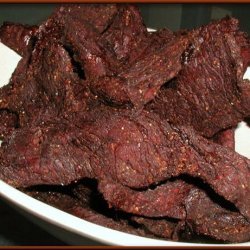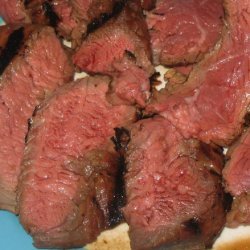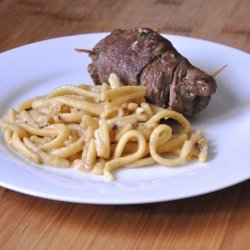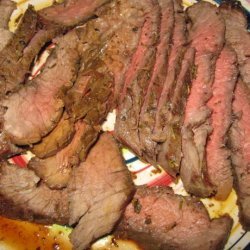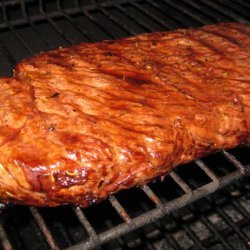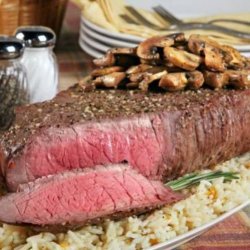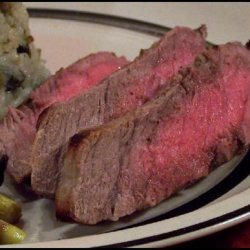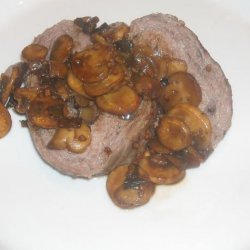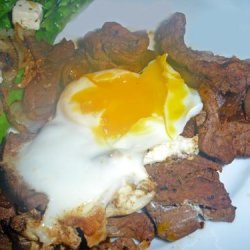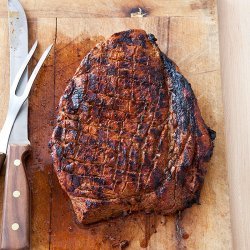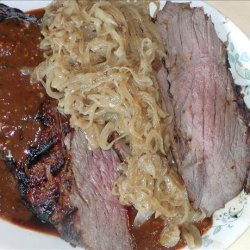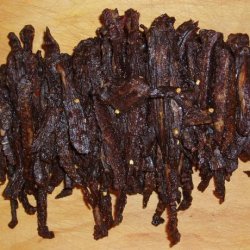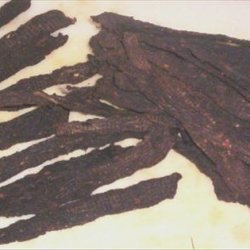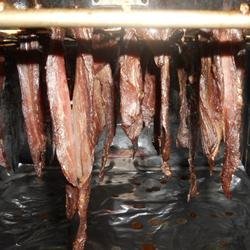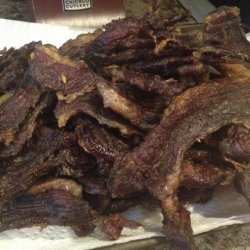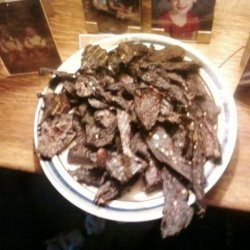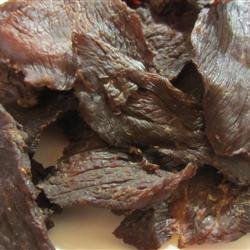Directions:
- Lets get our selves ready first to actually make Beef Jerky with some preparation. I can not stress enough about food safety practices here. You are about to preserve meat in a way that requires a low temperature cooking and drying method and you are the preparer; You are the one that has to take these tips I share with you to heart and prepare with care or love.
- The meat needs a storage container that is sterile and clean, I suggest getting a food container of the likes you can find at any good restaurant supply store or Costco, Sams Club in their food pro catering Isle a nice deep square/ rectangular non reactive container with a very tight fitting lid. Various Tupper Ware types will work but make sure you have an air tight seal that won't give in a few hours or days. We need it air tight.
- Consider your cutting area we need a good clean butcher block or meat cutting area.
- Finally, gloves it may help to have some gloves to ensure cleanliness.
- Okay lets begin:.
- Preparation, the CUT:.
- Take your London Broil and identify the grain of the meat, and cut along the grain 1/4 inch to just under 3/8 of an inch thick strips. Your London Broil is usually about an inch plus thick slab of meat. So take each slice and portion that slice length wise to about the same first dimensional cut of about 1/4 inch to 3/8 inch. Now you should have long strips of meat that are about the thickness of a lady's finger. This is important in the final quality of your jerky. I have found staying very close to a precise 1/4 inch precision cut strip to no larger than 3/8 will yield a chewy, but tender result that will satisfy. Many cut into thin wide slices but bare with me and give this recipe a try and reserve your judgements for the final product.
- Marinading, THE CURE:.
- We are going to layer the meat, and dress with salt and molasses. We will layer each layer of meat in a directional manner. First layer, lay strips North to South the next layer will be East to West - But wait Read below first - Start with your first layer of meat laid North to South covering the bottom of the container completely no spaces no overlaps.
- This is very critical and it does take a steady hand to prepare your cure box with just the right application of salt and molasses. So WARNING, please read this first do not just dive in - Okay we need to lay down the salt, I like to start by swinging the Kosher salt box over the curing container that you will store your beef in a back and forth manner that is level and parallel to the meat surface in a nice controlled manner and as you tilt the salt box in your hand over the curing box the salt will begin to throw out nice and even. Important we are not trying to make a perfect layer to cover every square inch of the meat. That would be too much salt, a proper salt layer will actually have granules of salt about every 1/8 to about a 1/4inch of the meat. I know that sounds salty nonetheless but trust me, it is about right. You might want to practice over a baking sheet a little to get your technique down, I highly recommend practicing.
- Okay great now the Molasses, you want to have the same control here in the application by pouring the molasses with an even parallel swing but slower, its molasses and you want a small thread of molasses to begin pouring out and just as the molasses begins to clear the bottle neck pull back the tilt a bit to reduce it to that very fine thread that will flow in a thread like manner. Now swing back and forth nice and steady laying a thread of molasses at a coverage of about one line space per 1/8 inch North and South, then come back and lay a thread at 1/8 spacing East and West. Wheh - You did it -
- Okay great now your next layer, remember this time alternate the direction of the meat lay this layer East to West. Fill the layer completely no spaces. Repeat layering salting, and molasses application till you have no more meat. Cover tightly and refrigerate for one week. Then you are ready for smoking in a smoker. I have marinated/Cured Jerky up to two weeks with no problems, if you are adding flavors and seasonings to this curing process then increasing curing time can be beneficial. see tips at the end of the recipe.
- Managing the CURE:.
- Leave your Curing Meat undisturbed in the refrigerator for two days. straight. Once you have two days in to the curing process you can now redistribute the contents. This is important to insure we get an even cure on all of the meat try to get what is on the bottom to the top and the top to the bottom. I hope that makes sense, in other words if you wish you could take a clean spatula and just slip it in one side and just flip the contents over don't worry that all your neat layers are now in disarray that is fine. Do this every day now flipping the contents till you have a full week into curing the meat.
- Ready to JERK:.
- One week later your London Broil Strips are now cured. Believe it or not your jerky is safe to eat, but I do not think it would be very appetizing. It will be soon and we are more than half way there but a little more TLC and we will have the best of the best, The Real McCoy of Jerky in your hands soon.
- Remove Jerky from the the confines of your fridge.
- Prepare your Smoker with wood natural lump charcoal, light and bring your smoker to a operating temp of 170 degrees F. try to keep it below 200 degrees F. as you maintain this heat level. Prepare your choice of wood chunks by soaking them in water, I prefer Hickory, but all nut or fruit bearing hardwoods are fair game. Clean your racks and lightly oil them but once oiled clean of with a paper towel we do not need the racks oiled heavily. I like to have the very bottom rack covered in tinfoil, if your fire and heat is coming from below. this will cause a more even heat distribution and smoke distribution.
- Remove the meat and I like to strip the pieces with my hands wearing a food grade glove to remove most to nearly all the marinade. Some of you will fret for the sake of flavor but the less moisture you have on the meat and in the smoker the better to insure our drying time is on cue.
- Prepare each rack for your smoker by laying the strips across the grate with at least a 1/8 inch of air space between strips. Fill the racks densely though because the fewer racks to rotate in the smoker the better. Place the Beef lined racks in the smoker and maintain the smoker at about 170 degrees F. add wood chunks to add smoke flavor. If your accustomed to smoking you probably have a feel for what is too much smoke or too little. You want a slow steady procession of fresh smoke gently rising with the heat. Use lots of ventilation on your smoker we want the heat to carry away the moisture so do not dampen heavily less you need to squelch a flare up that is causing your temp to sore. Best to ad fuel sparingly. Check the racks of meat about every 30 minutes. Ensure to rotate as needed over under or to just rotate the racks in a clock wise rotation to ensure even drying. Here is what I find works best for smoking and drying time; expect 4 hours at about 170ish to 200 degrees F. and then you may want to stoke the fire then you may want to stoke the fire up one last time at 4 hours to about 200 degrees and then just as that fuel dwindles, fully vent the smoker and allow to air dry to full cool for another four hours. Remove from smoker, remove from racks. You know it is right when you bend the meat you will see it give into exposing the meat fibers in the bend and possibly splinter slightly. If it splinters easily you are to dry, if it bends but will not expand and expose meat fibers to a few splintering it needs more drying time. You can air dry on baking racks inside, or in your oven to perfection. Another great gauge for perfection is your pallette go ahead and try it dry to your liking this thick cut should be chewy, but pleasant to work and not be so hard to cause severe gum and mouth abrasion. I hope that all makes sense here.
- Storing: Once you have your finished product it is important to store correctly. Zip locks are great and even vacuum packing is better, with each batch of jerky store with two paper towels folded into a single flat to lay on one side of the bag. The Paper towel will help with collecting moisture and keep your product in better shape. It is completely normal to see the paper towel wick a colored stain into itself. change the paper towel on longer stored jerky. Room temperature for short periods is fine say a week to ten days. Longer storage you can freeze up to many months, or refrigerate for many weeks.
- Tips on Flavor:.
- Okay the natural smoke flavor of the Real McCoy already should make you feel as though all Jerky you ever, ever, ever ate from a mass producer is only fit for a Dog. I know the first time i made it just as described I nailed it not too salty, not too sweet and the London Broil was a premium cut with next to no fat or connective tissue just pure premium meat. My dogs were smelling this for hours in the smoker and when I had the first chew I got that overwhelming feeling so primal and so natural of an instinct to hunker down and cover myself from prying eyes as though I discovered a very special secret - Like striking gold and hiding the prize from claim jumpers. So all by it's simple self this recipe screams perfection.
- To jazz things up here are my best tips from my years of production and trials. If you want heat then make as per the recipe above but dust the finished product with Ground Red Pepper when storing - Making a heated up hot sauced marinade will only mellow in the smoker and the pepper sauce and spices may take on more bitters of the smoking process. Seasoning with spices is always better at storage time. Try making your favorite smice rubs and blends and see what you think.
- My favorite and very best of the best recipes has been the addition of julienned strips of Habenero peppers, and a product called Sweet Spicy Ginger Teriyaki, from East West Specialty Suaces - Pouring the liquid marinades, citrus, peppers, or red pepper flakes in after your two day soak is best - It is not necessary to add your flavor ingredients in the first production of making layers. I encourage you to let the curing of the salts and sugars of the molasses to do their job first then flavor it all up in the toss up and flip of the meat after your two day cure soak. I have found this to work the best.
- Enjoy and please, comment feel free to comment, our journey in the pursuit to the REAL Mc Coy is a shared experience and collaboration of us working to the same pursuit of hapiness. Cheers.
Nutrition Facts
| Amount Per 1 Serving | |||
| Calories | 0 Kcal (0 kJ) | ||
| Calories from fat | 0 Kcal | ||
| % Daily Value* | |||
| Total Fat | 0g | 0% | |
|---|---|---|---|
| Amount Per 100 g | |||
| Calories | 0 Kcal (0 kJ) | ||
| Calories from fat | 0 Kcal | ||
| % Daily Value* | |||
| Total Fat | 0g | 0% | |
|---|---|---|---|
* Percent Daily Values are based on a 2000 calorie diet. Your daily values may be higher or lower depending on your calorie needs.
Find out how many calories should you eat.
Get Your Recipe of Health!
Follow RecipeOfHealth on Facebook!



